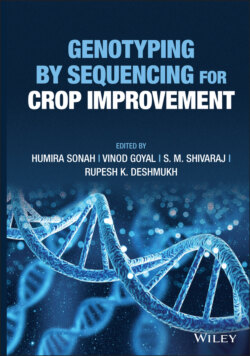Читать книгу Genotyping by Sequencing for Crop Improvement - Группа авторов - Страница 32
1.7 Application of Molecular Markers 1.7.1 Application of Molecular Markers in Crop Improvement
ОглавлениеMolecular markers have several applications in genetic studies and crop improvement programs. These have been used in the development of saturated linkage maps, gene/QTL mapping, map‐based cloning of genes, orthologous gene mapping, and marker‐assisted transfer of targeted genes/QTLs in the background of different cultivars/lines. Saturation of linkage maps refers to increased marker density to cover the entire chromosomal region. In general, when molecular markers are arranged on a linkage map with less than 1 cM distance apart, is considered as saturated linkage map. The development of saturated linkage maps could only be possible with the availability of molecular markers. These maps are prerequisite for gene/QTL mapping, map‐based cloning of genes, and MAS. Several molecular markers‐based saturated linkage maps have been developed in crop plants including rice (Harushima et al. 1998; McCouch et al. 2002; IRGSP 2005; Zhu et al. 2017; Kumar et al. 2018), wheat (Somers et al. 2004; Song et al. 2005; Poland et al. 2012; Li et al. 2015; Hussain et al. 2017), maize (Sharopova et al. 2002; Zhou et al. 2016; Su et al. 2017), and tomato (Tanksley et al. 1992; Haanstra et al. 1999; Sim et al. 2012). In one of the studies, a rice genetic map helped to enrich the genetic region of Ph1 locus of wheat and facilitated the identification of candidate genes governing the locus (Sidhu et al. 2008).
Plant breeders have relied heavily on generating new gene combinations and selecting these new gene combinations empirically. Though phenotype‐based selection has largely been successful, MAS has improved the efficiency and precision of selection. MAS can be practiced more efficiently for characters whose phenotypic selection is difficult. As an example, selecting a fertility restorer gene in segregating generations need test crossing before subsequent backcrossing. However, if such genes are tagged with molecular markers, desirable plants with fertility restorer genes (in heterozygous condition), can be identified and backcrossed. Similarly, if desirable genes conferring tolerance to abiotic stresses are tagged, these can be selected easily in segregating generations. Also, genetic markers can be assayed in nontarget areas such as growth chambers, greenhouses, or off‐season nurseries, thus permitting more rapid progress. The efficiencies of scale and time accorded by DNA markers are valuable in breeding horticultural plants where fewer individuals might save several hectares and fewer generations may save several decades (Paterson et al. 1991). MAS has been used efficiently in (i) gene pyramiding (Huang et al. 1997; Singh et al. 2001; Bhatia et al. 2011; Kumar et al. 2013; Yasuda et al. 2015), (ii) marker‐assisted alien introgressions (Jena et al. 1992; Brar and Dhaliwal 1997; Elkot et al. 2015), and (iii) simultaneous identification and pyramiding of QTLs from primitive cultivars and wild species (Tanksley and Nelson 1996; Tanksley et al. 1996; Fulton et al. 1997; Xiao et al. 1996, 1998).
